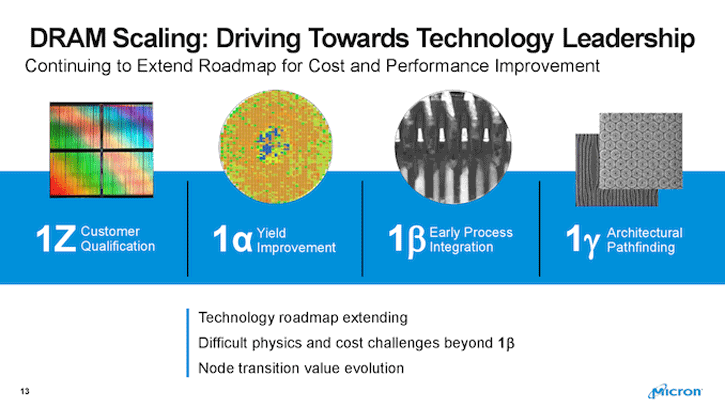Micron announced 1-alpha node DRAM, a leap in DRAM process technology that significantly improves bit density, power, and performance for applications from data centers, mobile devices to smart vehicles.
Compared to the previous 1z generation, the 1-alpha node offers a 40% improvement in memory density. Mobile devices built with Micron’s low-power DRAM from this new node will benefit from a 15% improvement in power savings. With these improvements, 5G users can multitask with data-intensive applications on their smartphones without draining the battery. The chipmaker intends to shrink the cell or process node size progressively with the following steps, starting from the no longer mainstream 20nm node process size to the 10nm (19nm-10nm range) node process:
- 1Xnm – (c19-17nm) older DRAM technology process node size
- 1Ynm – (c16-14nm) mainstream DRAM bit production technology today
- 1Znm – (c13-11mn) 15 per cent of Micron DRAM bit production in 3Q20
- 1αnm process node – 1 alpha – volume production in first half of 2021
- 1βnm process node – 1 beta – in early development
- 1ɣnm process node – 1 gamma – early process integration
- 1δnm process node – 1 delta – pathfinding and may need EUV technology
The 1 delta node size is a recently new entry on Micron’s DRAM roadmap. For DRAM particularly, the name of the node usually corresponds to the dimension of half of the pitch — the “half-pitch” — of the active area in the memory cell array. As for 1α, you can think of it as the fourth generation of the 10nm class where the half-pitch ranges from 10 to 19nm. As they go from 1x nanometer to 1y, 1z and 1α, this dimension gets smaller and smaller. They started with 1x, but as they continued to shrink and name the next nodes, they hit the end of the Roman alphabet. That’s why they switched to the Greek alphabet alpha, beta, gamma and so on.
BOISE, Idaho, Jan. 26, 2021 (GLOBE NEWSWIRE) -- Micron Technology, Inc. (Nasdaq: MU), today announced volume shipment of 1α (1-alpha) node DRAM products built using the world’s most advanced DRAM process technology and offering major improvements in bit density, power and performance. This milestone reinforces Micron’s competitive strength and complements its recent breakthroughs with the world’s fastest graphics memory and the first-to-ship 176-layer NAND.
“This 1α node achievement confirms Micron’s excellence in DRAM and is a direct result of Micron’s relentless commitment to cutting-edge design and technology,” said Scott DeBoer, executive vice president of technology and products at Micron. “With a 40% improvement in memory density over our previous 1z DRAM node, this advancement will create a solid foundation for future product and memory innovation.”
Micron plans to integrate the 1α node across its DRAM product portfolio this year to support all environments that use DRAM today. The applications for this new DRAM technology are extensive and far reaching — enhancing performance in everything from mobile devices to smart vehicles.
Micron continues memory leadership momentum across multiple market segments
“Our new 1α DRAM technology will enable the industry’s lowest-power mobile DRAM as well as bring the benefits of our DRAM portfolio to data center, client, consumer, industrial and automotive customers,” said Sumit Sadana, executive vice president and chief business officer at Micron. “With our industry leadership in both DRAM and NAND technology, Micron is in an excellent position to leverage the growth in memory and storage, which are expected to be the fastest growing segments in the semiconductor industry over the next decade.”
Micron’s 1α DRAM node will facilitate more power-efficient, reliable memory solutions and provide faster LPDDR5 operating speeds for mobile platforms that require best-in-class LPDRAM performance. Micron’s innovation brings the industry’s lowest-power mobile DRAM, with a 15% improvement in power savings,1 allowing 5G mobile users to perform more tasks on their smartphones without sacrificing battery life.
Micron’s advanced memory node supports densities from 8Gb to 16Gb, offering the flexibility to sustain many of Micron’s current DDR4 and LPDDR4 products while giving Micron’s server, client, networking and embedded customers the power-efficient, reliable, extended product support they need. This longevity reduces the cost of customer requalification within their own product lifecycles. It also ensures better total cost of ownership over the system life in use case scenarios such as embedded automotive solutions, industrial PCs and edge servers that typically have longer lifespans. Micron’s Taiwan fabs have begun volume production of 1α node DRAM, starting with DDR4 memory for compute customers and Crucial consumer PC DRAM products. Micron has also begun sampling LPDDR4 to mobile customers for qualification. The company will introduce additional new products based on this technology throughout calendar 2021



